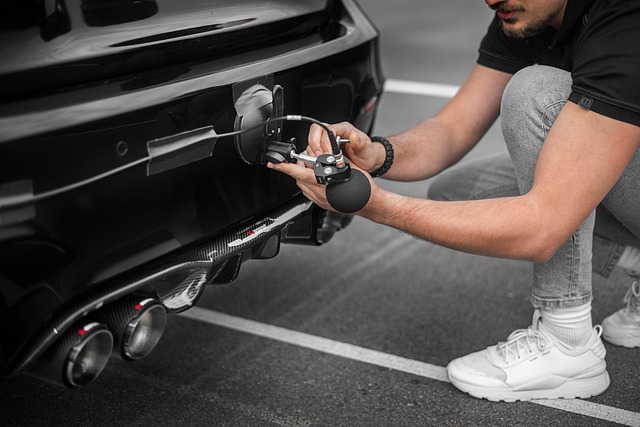“Unsure about how to register your car in California? This comprehensive guide breaks down the process step by step. First, understand the eligibility criteria and gather essential documents for a seamless DMV VIN verification. Prepare your vehicle for inspection by knowing what to expect during this crucial check. Then, follow our simple registration process and post-registration tasks like insurance and tag acquisition. Ensure ongoing compliance with maintenance tips.”
- Understand Eligibility and Requirements for Car Registration in California
- Gather Necessary Documents for DMV VIN Verification
- Prepare Your Vehicle for Inspection: What to Expect During VIN Verification
- Complete the DMV Registration Process: Step-by-Step Guide
- Post-Registration Steps: Insurance, Tags, and Maintaining Your Vehicle's Compliance
Understand Eligibility and Requirements for Car Registration in California

Before registering your car in California, it’s crucial to understand the eligibility and requirements set by the Department of Motor Vehicles (DMV). One key step is ensuring that your vehicle meets all safety standards and emissions regulations. Additionally, a valid vehicle identification number (VIN) verification is mandatory. This process, often facilitated through a mobile VIN verification or vin inspection, confirms that the car’s details match the information on record, enhancing security and preventing fraud.
The DMV requires accurate documentation, including proof of ownership, valid insurance, and sometimes, depending on the vehicle’s age and type, a safety inspection. It’s important to gather all necessary documents before attempting the vin inspection, as this can streamline the registration process significantly. Make sure your car is eligible for registration in California by checking the DMV guidelines, which outline specific requirements for various types of vehicles.
Gather Necessary Documents for DMV VIN Verification

Before heading to the DMV for car registration, ensure you have all the necessary documents ready for a smooth dmv vin verification process. This includes your vehicle’s registration certificate, proof of insurance, and a valid driver’s license. Additionally, gather important paperwork related to ownership transfer if applicable. A mobile vin verifier or mobile vin inspection can be handy here—these services allow you to quickly double-check your vehicle’s history and specifications before visiting the DMV, saving time and effort.
For a seamless vin inspection, have your vehicle identification number (VIN) ready as it’s a crucial piece of information for the DMV staff. They will verify the VIN against state records to ensure the vehicle matches the details on your documents. Properly prepared documentation ensures that the registration process is efficient, and you can hit the road with your new California registration plates in no time.
Prepare Your Vehicle for Inspection: What to Expect During VIN Verification

Before heading to the California DMV for registration, ensure your vehicle is ready for inspection by preparing certain documents and understanding what to expect during the VIN (Vehicle Identification Number) verification process. This crucial step involves a thorough check of your car’s identity and history, which is essential for ensuring road safety and preventing fraud. During the dmv vin verification, a qualified inspector will examine your vehicle’s unique VIN, often using advanced technology like mobile vin verifiers or even conducting a manual vin inspection if necessary.
You can facilitate this process by gathering all required documents, including your vehicle registration, proof of insurance, and valid driver’s license. It’s equally important to ensure the vehicle is in good working condition, as any significant modifications or damage may require additional explanations or repairs before the dmv accepts the registration. Be prepared for a detailed inquiry into your car’s history, as the inspector will cross-reference the VIN data with their databases to verify its authenticity and identify any potential issues, ensuring that your vehicle meets all safety standards before it hits California’s roads.
Complete the DMV Registration Process: Step-by-Step Guide

Completing the DMV registration process is a straightforward procedure, but it requires careful attention to detail. First, gather all necessary documents, including your vehicle’s registration from the previous state (if applicable), proof of insurance, and a valid driver’s license. You’ll also need the Vehicle Identification Number (VIN) from your car, which can be located on the vehicle’s title or by checking under the hood. The DMV offers both in-person and online registration options, but for a smoother experience, many opt for the mobile vin verification method.
With a mobile vin verifier app, you can conveniently complete the VIN verification process right from your smartphone. Simply input your VIN, follow the on-screen instructions, and upload any required documents. This digital approach streamlines the registration, saving you time and effort compared to traditional methods. Once all information is confirmed accurate, including the vehicle’s make, model, year, and current mileage, submit your application and pay the registration fees.
Post-Registration Steps: Insurance, Tags, and Maintaining Your Vehicle's Compliance

After successfully registering your vehicle with the California DMV, there are several crucial post-registration steps to complete to ensure your car’s legal status and safety. One of the most essential is obtaining insurance coverage that meets the state’s minimum requirements. You’ll need to provide proof of this insurance during future interactions with the DMV, such as when renewing your registration or making changes to your vehicle.
Additionally, you’ll want to obtain and display proper vehicle tags, which serve as a visual reminder of your registration status and essential for law enforcement identification. Regularly check that your vehicle passes emissions tests and safety inspections, often conducted through a mobile vin verifier or local inspection station, to maintain compliance with California’s strict vehicle regulations. This includes keeping up-to-date records of all maintenance and repair work performed on your car, as documented by the DMV’s vin inspection process.
Registering a car in California involves understanding eligibility criteria, gathering essential documents for DMV VIN verification, preparing your vehicle for inspection, completing the registration process step-by-step, and taking post-registration steps like insuring your vehicle and displaying proper tags. By diligently navigating these processes, you’ll ensure your vehicle’s compliance and enjoy the benefits of legal operation on California’s roads. Remember, a well-maintained vehicle not only enhances safety but also contributes to a smoother registration experience.



